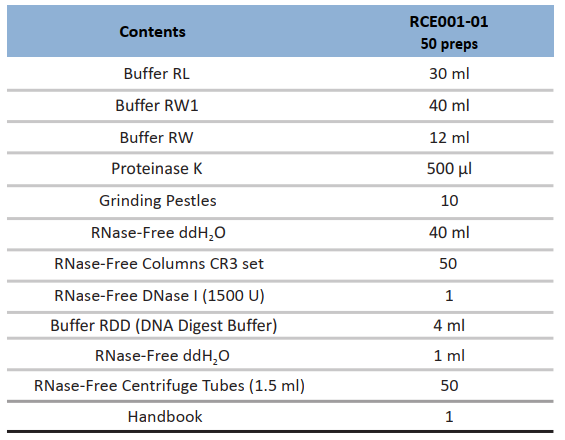The Animal Total RNA Kit is specifically designed for total RNA isolation from animal tissues in a fast, simple, and cheap manner. Proteins and genomic DNA contamination in-plane tissues are removed using proprietary silica-membrane technology, a special buffer solution, and a proprietary DNase I. Total RNA that has been purified can be used directly in molecular biology experiments such as RT-PCR, Real-time RT-PCR, Northern Blot, and RNA library construction. DNase I, Buffer RDD, and RNase-Free ddH2O (tubular) should all be kept at 2-8°C. The buffer RL/-mercaptoethanol mixture can be stored for one month at 4°C. Other reagents can be kept at room temperature (15-25°C) for a long time. Animal tissue in the quantity of 10-20mg is approved as a sample type.
Storage:
DnaseⅠ, Buffer RDD and RNase-Free ddH2O (tubular) should be stored at 2-8℃. Buffer RL/β-mercaptoethanol mix can be stored at 4°C for 1 month. Other reagents can be stored at room temperature (15-25℃).
Components:

Specifications:
| Sample amount | 10-20mg |
| Features | Optimized buffers for plane tissue samples enables a fast and convenient workflow for total RNA isolation within just 40min. No phenol-chloroform extraction enables the workflow more safety. |
| Application | The purified total RNA can be used directly for molecular biological experiments such as RT-PCR, Real-time RT-PCR, Northern Blot, and RNA library construction, etc. |
| Species Category | animals |
| Sample type | animal tissues |
Protocol
- Disrupt the tissue and homogenize the lysate.
Place the 10-20 mg tissue in liquid nitrogen immediately, and add 300 μl Buffer RL (Ensure that β-ME has been added to Buffer RL before use). Grind tissue thoroughly with a pestle. Add 590 μl RNase-free ddH2O to the lysate. Then add 10 μl proteinase K solutions, and mix thoroughly by pipetting. Incubate at 56°C for 10-20 min.
Note: Determine the amount of tissue. Do not use more than 20 mg. - Centrifuge for 2-5 min at 12,000 rpm (~13,400 × g). Carefully transfer the supernatant to a new microcentrifuge tube (not supplied).
- Add 0.5 volume of ethanol to the cleared lysate, and mix immediately by pipetting. Transfer the sample, including any precipitate that may have formed, to RNase-free Spin Column CR3 placed in a 2 ml RNase-free Collection Tube. Close the lid gently, and centrifuge for 30-60 s at 12,000 rpm (~13,400 × g). Discard the flow-through.
- Add 350 μl Buffer RW1 to the RNase-free Spin Column CR3 Close the lid gently, and centrifuge for 30-60 s at 12,000 rpm (~13,400 × g). Discard the flow-through.
- Preparation of DNase I working solution: Add 10 μl DNase I stock solution (see Preparation of DNase I stock solution) to 70 μl Buffer RDD. Mix by gently inverting the tube.
- Add the DNase I working solution (80 μl) directly to the RNase-free Spin Column CR3, and place on the bench top (15–25°C) for 15 min.
- Add 350 μl Buffer RW1 to the RNase-free Spin Column CR3. Close the lid gently, and centrifuge for 30-60 s at 12,000 rpm (~13,400 × g). Discard the flow-through.
- Add 500 μl Buffer RW to the RNase-free Spin Column CR3. (Ensure that ethanol has been to added Buffer RW before use) Close the lid gently, incubate for 2 min at room temperature and centrifuge for 30-60 s at 12,000 rpm (~13,400 × g). Discard the flow-through.
- Repeat step 8.
- Centrifuge for 2 min at 12,000 rpm (~13,400 × g) to dry the spin column membrane.
Note: The long centrifugation dries the spin column membrane, ensuring that no ethanol is carried over during RNA elution. Residual ethanol may interfere with downstream reactions. - Place the RNase-free Spin Column CR3 in a new 1.5 ml RNase-free Collection Tube (supplied). Add 30-100 μl RNase-free ddH2O directly to the center of spin column membrane. Place at RT for 2 min, close the lid gently, and centrifuge for 2 min at 12,000 rpm (~13,400 × g) to elute the RNA.
Note: Volume of elution buffer should no less than 30 μl, or else it will reduce elution efficiency. Purified RNA may be stored at –70°C.



